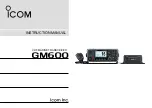
61
7
DV MODE OPERATION
7
D
Calling a specific station
q
Set the desired frequency. (p. 23)
• Select output power, if desired. (p. 27)
w
Set the current call sign to your own call sign. (p. 47)
e
Set the current UR call sign. (p. 47)
UR call sign selection
q
Push and hold
[UR]
(
.
) for 1 sec. to enter UR call sign
selection mode.
• Push
[BAND]
several times to select “GRP CQ” (CQCQCQ)
“GRP UR” (UR call sign memories) and “CS” (current call
sign).
• DV mode is automatically selected.
w
Rotate
[DIAL]
to select the specific station call sign.
e
Push
[UR]
(
.
) to return to the frequency screen.
r
Push and hold
[PTT]
to transmit and speak into the micro-
phone at normal voice level.
• Tx/Rx indicator lights red and the RF meter shows the output
power.
• UR call sign is displayed and scrolled on the frequency display
depending on “TX CS” setting (p. 135).
t
Release
[PTT]
to return to receive.
• The other station’s call sign will be received.
• Received call signs can be stored into the received call record
automatically. See page 49 for details.
• Current call sign setting example (Simplex call)
My call sign
:
JA3YUA
Station call sign
:
JG3YMK
UR
MY
R1: (NOT USE)
R2: (NOT USE)
NOTE:
The digital mode operation is vastly different from
FM mode. One of the differences is that in digital mode
the squelch does not function as in FM mode. Changing
the squelch setting will not open it to hear the hiss of
“white noise.” It only activates for digital squelch functions
such as CSQL
(Digital code squelch)
or D SQL
(Digital call
sign squelch)
.
1
2
3
4
5
6
8
9
10
11
12
13
14
15
16
17
18
19
Summary of Contents for IC-E80D
Page 184: ...176 MEMO...
Page 185: ...177 MEMO 1 2 3 4 5 6 7 8 9 10 11 12 13 14 15 16 17 18 19...
Page 186: ...178 MEMO...
Page 187: ...179 MEMO 1 2 3 4 5 6 7 8 9 10 11 12 13 14 15 16 17 18 19...
















































